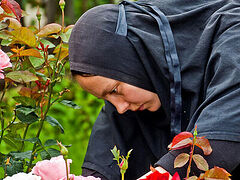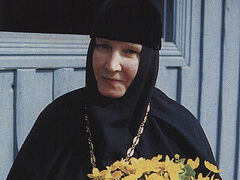Founded in the twelfth century by the Venerable Barlaam of Khutyn (feast: November 6/19) as a community for monks, the Holy Transfiguration Convent of the Novgorod Diocese still exists today. The monastery was closed in 1925, but until 1932 services were still celebrated in the monastery cathedral. During the Great Patriotic War (1941-1945) the monastery was destroyed and remained in ruins for over forty years. It was revived as a convent by the decision of the Russian Orthodox Church’s Holy Synod on April 20, 1994. The assistant to the abbess of the convent, Nun Nonna (Tarasova), has talked about the revival of the Holy Transfiguration-St. Barlaam of Khutyn Convent and its life today.
—Mother Nonna, please tell us how the monastery came into being?
—The Holy Transfiguration-St. Barlaam of Khutyn Monastery was founded in the mid-twelfth century by the Venerable Barlaam. He came for solitude and prayer to a spot called “Khutyn” (meaning “a bad place”), notorious for evil spirits. Here the saint built a log cell for himself. Then a wooden church appeared, and eventually a monastery was established. In the twentieth century it was closed and destroyed.
—When did the restoration work start?
—The convent was returned to the Church in 1991. Metropolitan Leo of Novgorod and Staraya Russa appointed our mother-superior—then still a nun—Alexia (Simdyankina) abbess of the ruined convent. From April 1994, the convent began to live a new life. Day-to-day life in the convent was set straight, and the abbess received Vladyka’s blessing for our activities. A priest was sent to us, and he still lives in the convent. Now he is already an archimandrite—Fr. Makary (Shamsudinov). First of all began liturgical life—the first service was celebrated in 1994 on Palm Sunday. Pascha was on May 1, and our first parishioners appeared.
—How was the convent restored? What did you arrange first of all?
—The mother-superior moved in with the first nuns in the spring to plant vegetables in the kitchen garden. We were given a cow, whose offspring are still alive. We got life in the convent going full swing. The cells had not been completed yet, they were rooms with bare walls without doors. We served the entire liturgical cycle of the year. If were not for St. Barlaam’s prayers, it is unlikely that all this would have taken place. Prayer is the source of life and prosperity of any monastery.
—What was the happiest event in the 1990s?
—We were very happy when we received bells. Imagine: between 1994 and 1997 we went to church in silence, because the bell tower was covered in scaffolding—everything was in ruins. And when three small bells appeared and we were able to ring them during services, we were filled with joy. The services sounded different. Only later in 2001 was the scaffolding removed from the bell tower and then bells weighing many tons were hung. But between 1997 and 2001 we rang three small bells.
—How do you live now? What is your daily routine?
—According to the monastic rule, morning prayers begin at seven. After prayers we sing the akathist of the day according to the liturgical cycle and celebrate the Liturgy. As a rural convent we live on the land, so there is a lot of work in the summer. During the summer season only the older nuns and the singers and readers are present at the Liturgy. The others have breakfast at eight and go to perform their obediences. We currently have fifty sisters.
—How many of them are old, and how many are young?
—We have been reviving the convent for twenty-eight years.
When we arrived here, there were twenty-two of us sisters, and almost all of us were under thirty. Now we are older. There are about five young sisters today who are under thirty, but most of the nuns are between thirty and fifty years old. Several nuns are over seventy.
—Please tell us how work in the fields is going now—at the height of the season?
—We have many fields and pastures—hectares of land. We have equipment, a tractor, which plows and mows the grass. We ourselves used to mow, putting it in haystacks. Now our tractor driver (thanks to the mother-superior) does everything with the help of equipment. We grow potatoes, carrots, beets, cabbages, onions... This, of course, requires work and weeding.
Many families with children are coming to us, and there are many large families among our pilgrims. They help us too. We have some sisters who used to come to us when they were little girls. We asked them to weed our onions, because they had small hands and would not damage the leaves. These girls have grown up: they are already over twenty-five. Other girls come and help us too. People of different ages, occupations and ranks, women and men work with us. Our fields are vast and hard to manage.
—Do you reap big harvests?
—Per season we harvest 500 tons of potatoes, five tons of cabbages, eight tons of beets, six tons of tomatoes, twenty-five tons of carrots, and thirty-five tons of onions. Monasteries and convents traditionally had farms and lands for plowing. In the Synodal period this monastery was an idiorrhythmic first-class monastery. But this is just for statistics... This is all the sisters’ work, which the Lord rewards.
—What do you do besides work the land? What are your obediences?
—We have obediences traditional for any convent. There are church obediences: Some sing in the choir, others help in the altar, and others keep order in the church. Such obediences are assigned to almost all the sisters, who take turns.
We are a rural convent, located in the countryside. We have plenty of land, fields, vegetable gardens and flower gardens, which we take care of during the summer. There are also obediences in the cow barn and on the convent’s farm. We have the traditional obedience of needlework; we sew icon covers, vestments for the clergy, and monastic clothing for ourselves. There are also obediences in the convent’s office—answering letters from pilgrims, receiving prayer lists and donations. Naturally, there are obediences in the convent’s kitchen, in the refectory for pilgrims and the pilgrims’ guesthouse.
—Is the guesthouse big? How many pilgrims can it accommodate?
—We have a large dormitory room for pilgrims, which has served us since the first years. It is designed for twenty people. And we have a restored guesthouse on the historic site of the south building of the former monastery. About seventy people can be accommodated there simultaneously. During the active pilgrimage season, we also accommodate people in the guesthouse conference hall. Monastic and diocesan meetings are usually held there. Just as we arranged for our guests to sleep on the church floor when we did not have enough rooms for all the pilgrims, so we bed them down here too, so that everyone can find a place. Even in spartan conditions they still stay overnight. Many know and love St. Barlaam and come here to pray to him.
—Can you say that the convent is a family?
—A family is first of all your parents. We have a spiritual mother (our abbess) and a spiritual father—the Metropolitan, who performs tonsures. We live under the guidance, by the prayers and care of our spiritual parents. The mother will scold you if you are wrong, she will regret it if you are offended, and she will enlighten you if you are confused. So we turn with all our questions to our spiritual mentors as to our parents.
Although situations vary. We are not always obedient. The human way of life leaves its mark. People do not become angels instantly when they come to a monastery or a convent, as some believe. Special attitudes and ways of expressing ourselves are expected from us, as if this were our only church and monastic aspect of life. Of course, we come here with our weaknesses, habits and shortcomings, which sometimes get exaggerated in the monastic life. Sometimes people do not even expect that this or that can happen to them here.
There are also some “heated” moments that are resolved through love and instruction. Most importantly, we should remember the purpose for which we all came here. We must look for spiritual meaning and ask ourselves what we have done wrong in this situation. It is natural human life. We don’t live according to a template. Excessive demands are often made on monastics by secular people. Many think that we become perfect once we cross the convent’s threshold. But this is absolutely untrue. We are all living people and are called on to make efforts all our lives, striving to improve.
—How does the desire to join a monastic community arise?
—I think it’s a calling. Secular people often expect a romantic-tragic story about joining a convent, that someone goes to mourn her misfortune or tragedy for the rest of her life. A city guide, the servant of God, Oleg, gave me much inspiration many years ago. Bringing us some tourists who knew little about the Church and monastic life, he said that many believed that people join a monastery out of grief—but that is not true. People come to the monastery out of joy, out of love for God. Sometimes a sister comes here as a pilgrim or on a tour and, inspired when a ray touches her heart, she stays. We can’t talk about any circumstances. Circumstances vary, but only God’s call can be the reason for staying here to live and serve.
—What is the most difficult thing in monastic life?
—It is especially hard when we depart from the main principle of spiritual and monastic life. People often distinguish monastic life from life in the world and general Christian life, but the spiritual laws are the same for everyone. It doesn’t matter whether you wear a monastic mantle, a cassock or secular dress. The main law is obedience to God and service to God. If we only do things in our own way and act according to our will, then a temptation, a test for us begins. It’s not about purely physical difficulties, as many believe. Everyone has to do some physical work he is not used to, which is unknown and difficult for him. Many years ago there were absurd reports about how we supposedly dug up hectares of land with shovels. The idea of monastic service shouldn’t be taken to the point of absurdity—as if it were working to the point of exhaustion. This is obedience to God, which is also expressed physically. What is difficult for a person is not physically lifting a stone or digging up the ground—it is difficult when you become enslaved by your idea, your own way, and you can’t give up your own will.
Being a disciple is the essence of life. St. Barlaam is an example and model for us in this. He didn’t found the monastery out of his own desire to be a mentor and a teacher for the brethren. He was a monk and a hermit. The desire of his heart was to live in solitude; he left a monastery to retreat to this “bad place”—Khutyn, but people flocked to him, and the brothers implored him to become their abbot and the monastery’s founder.
In the akathist to St. Barlaam it is said about his time: “Thou didst not refuse being appointed by him [the archbishop.—Trans.], O abbot of the monastery founded by thee, even if thy spirit was tormented, fearing such a high position (ikos 6).” You have chosen and taken up this path, so do not depart from it! Neither from obedience, nor from situation that we will call temptations. There are also everyday problems and conflicts—but you must remain steadfast on your chosen path, and preserve the spark that once touched your heart.









